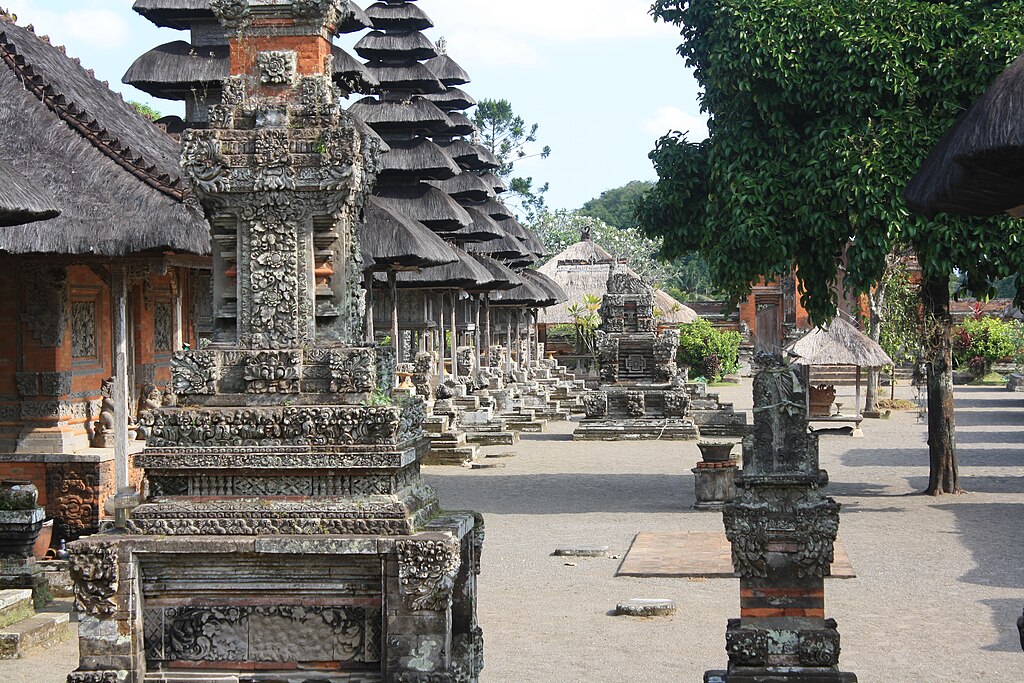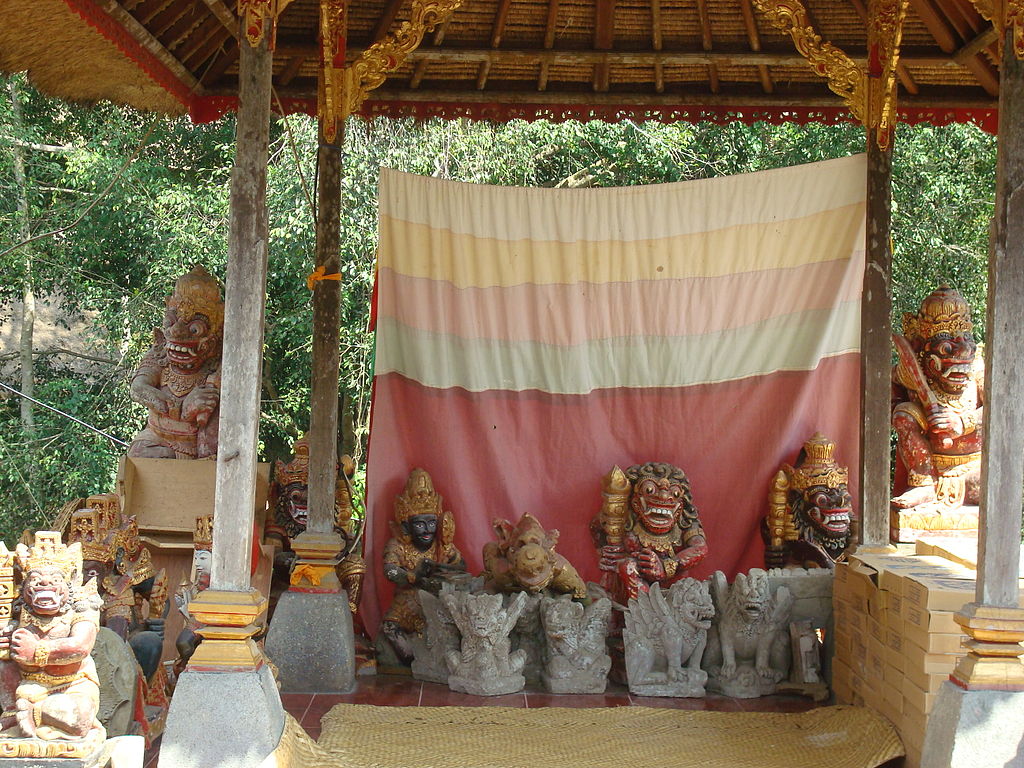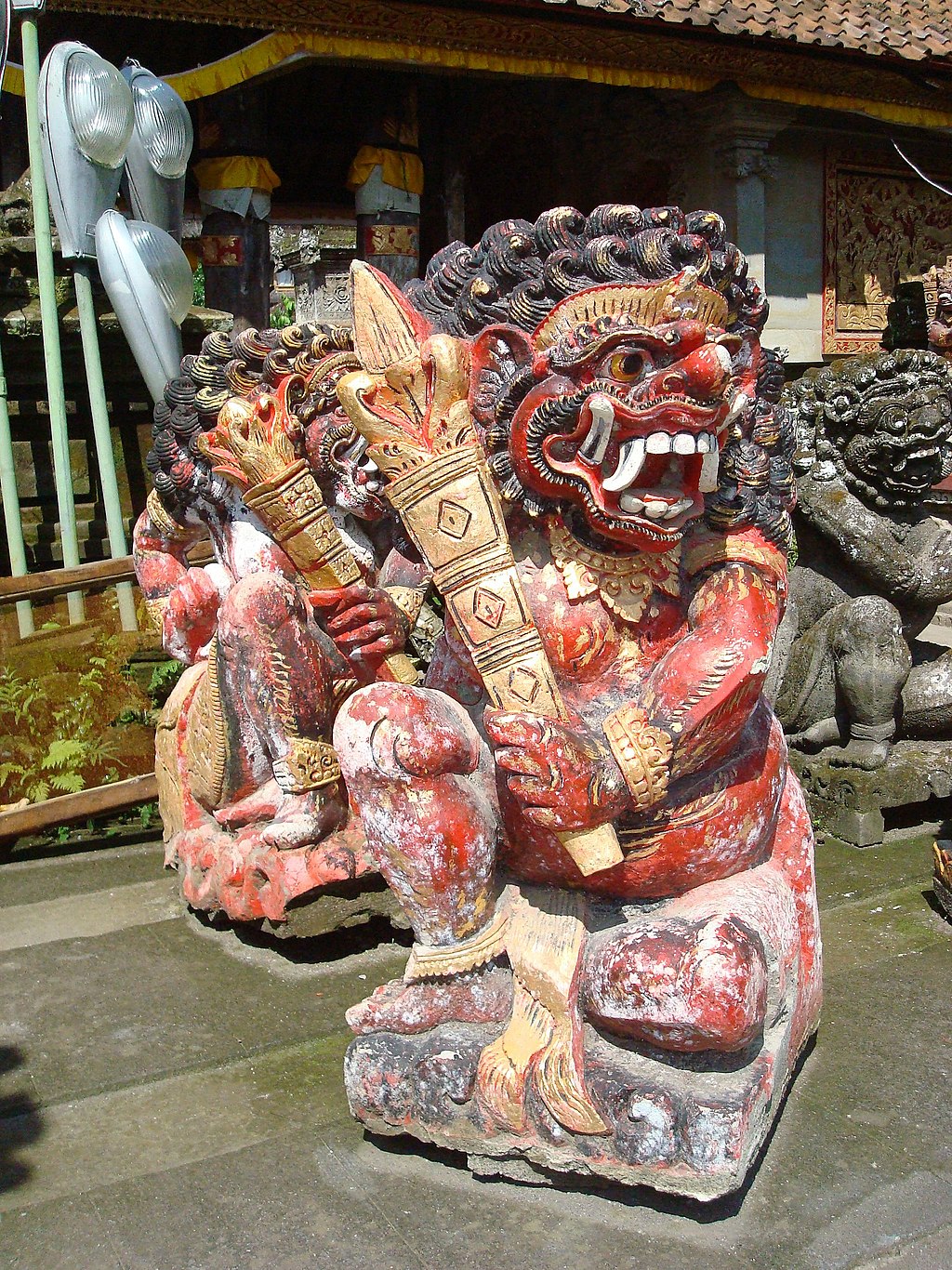Discover the Best Temples in Bali and You Must Visit Them
With over 20,000 temples in Bali, it’s hard to see them all in just 2 or 3 weeks. In this Best Temples in Bali article, we present to you our must visit temples in Bali. Then the choice is yours!
Bali is a tropical paradise that is famous for its stunning beaches, lush rice terraces, and vibrant culture. One of the essential aspects of Balinese culture is religion, and it is reflected in the numerous temples found all around the island. These temples are not just places of worship, but also important landmarks and tourist attractions that offer a glimpse into Bali’s rich history and tradition. Here are some of the must-visit temples in Bali that you need to explore during your stay.
Some of these temples are the most emblematic of Bali and are therefore very popular.
Discover the best temples in Bali, where the rich Hindu heritage is beautifully preserved, and immerse yourself in a spiritual journey that unveils the island’s sacred traditions, breathtaking architecture, and profound cultural significance, offering a unique opportunity to witness vibrant ceremonies, intricate stone carvings, ornate gateways, and serene surroundings that transport you to a realm of divine tranquility.
Here are some of the must-visit temples in Bali that you should add to your travel itinerary:
Tanah Lot
This iconic temple is perched on a rock in the middle of the ocean, making it one of the most photographed temples in Bali.
The temple of Tanah Lot (Tanah Lot means “The land in the sea” in Balinese), located in the South-West of Bali, is famous for its sunsets and its temple surrounded by the ocean according to the tides. At low tide, you can walk to the rock. The temple is dedicated to the sea God, Baruna, and is believed to protect the island from evil spirits.
Perched on a sea rock, it offers a stunning sunset view, making it one of Bali’s most iconic temples.
Tanah Lot, Bali. Technob105, CC BY-SA 3.0, via Wikimedia Commons
Tanah Lot is one of the most famous and iconic temples in Bali, and it is located on a rock formation that is surrounded by the sea. The temple is dedicated to the Balinese sea gods, and it offers a magnificent view of the sunset. Tanah Lot is a popular tourist destination, and it can get quite crowded during peak season, but it’s worth the visit.
Walk around Tanah Lot to observe the diverse sights. You will marvel at the beauty of the place, especially at sunset.
Legend
Legend has it that the sage once went to the rocky promontory that was then Tanah Lot, connected to the moor by a natural stone bridge. Captivated by the spectacle of the ocean caressing the banks and by the backwash of the waves, the man would have decided to spend the night there…
And in the early morning, in total harmony with the sea stretched out in front of him, he decided to build the temple to pay homage to this element of nature. Even today, the caves dug by the waves at the foot of the cliffs that surround it are said to be inhabited by sacred serpents, descendants of the former protectors of the site.

Tanah Lot beautiful sunset. Pinterpandai, CC BY-SA 4.0, via Wikimedia Commons
Useful information :
Address: Jl. Tanah Lot, Beraban, Kec. Kediri, Kabupaten Tabanan, Bali 82121, Indonesia
Admission: 60,000 rupees / adult, 30,000 rupees / child (+5,000 rupees for car parking, + 2,000 rupees for scooter parking)
Access: The road is in good condition, so you can easily reach the temple by car or scooter. At high tide, the temple is accessible only by boat.
Besakih Temple
Besakih Temple, nicknamed the “Mother Temple”, is located at the foot of Mount Agung in the village of Besakih, East Bali. At around 1000 meters above sea level, Pura Besakih is the most important and sacred temple in Bali, dedicated to the three deities of Balinese culture.
This is the largest and most important Hindu temple in Bali, and is located on the slopes of Mount Agung. It is a UNESCO World Heritage Site.
This temple is actually a complex of 23 separate temples that are dedicated to different Hindu deities. Each region of Bali has its own temple within Besakih Temple and is responsible for its upkeep. Besakih is an essential pilgrimage site for the Balinese Hindus, and it offers breathtaking views of the surrounding landscape.
Known as the “Mother Temple,” it is the largest and holiest temple complex in Bali, with a breathtaking mountain backdrop.
There are also three temples dedicated to the Hindu trinity: Shiva (the destroyer), Brahma (the creator) and Vishnu (the preserver).

Besakih Temple. Photo by CEphoto, Uwe Aranas (CC BY-SA 3.0) via Wikimedia Commons
The visit of Besakih is strongly recommended accompanied by a guide that you have chosen before your arrival on the site, it is one of the essentials in Bali. Indeed many false guides will try by all means to offer their services and they can be more than unpleasant.
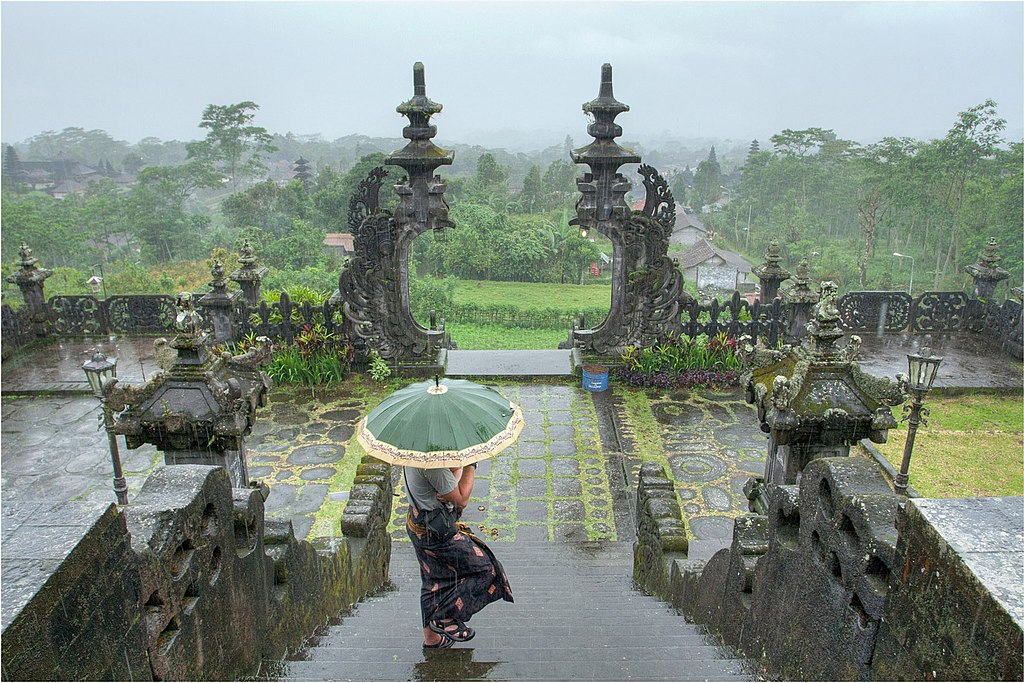
Pura Gelap in Mother Temple of Besakih. Tuderna, CC BY 3.0, via Wikimedia Commons
Four of the temples in the complex reflect the four forms of God through the cardinal points: Pura Batu Madeg to the north, Pura Kiduling Kreteg to the south, Pura Gelap to the east, and Pura Ulun Kulkul to the west.

Shiva temple at Pura Besakih. Chainwit., CC BY-SA 4.0, via Wikimedia Commons
Useful information:
Address: Besakih, Rendang, Karangasem, Regency, Bali 80863, Indonesia
Admission: 60,000 rupees / person (loan of the sarong, scooter ride for the climb, guide)
Access: To get there, you can take a taxi or hire a private driver or scooter is located at the entrance of a village where there is a car park. You can then either walk up or continue by scooter. From Kuta or Seminyak. Entrance fee: IDR 60,000 (about USD 4.20).
The bad reputation of the temple and the flight of tourists lead the authorities to react and reorganize access to the temple for tourists in better conditions than before. Here is the update communicated by a lebaliblog reader:
The entrance ticket is IDR 60,000 /person.
For this price there are:
- loan of the sarong (fabric that’s wrapped around the waist)
- scooter ride for the climb
- guide
It is possible not to take the sarongs, the scooter or the guide but the price remains the same. During our visit, there were no requests, so a great experience, certainly to be done given the new organization. To be specified, empty temple, its former bad reputation has taken it out of the standard circuit so good plan at the moment.
Ulun Danu Bratan Temple
This picturesque temple is located on the shores of Lake Beratan and is dedicated to the Hindu gods Brahma, Vishnu, and Shiva.
Ulun Danu Bratan Temple (Ulun Danu means “beginning of the lake” in Balinese), nicknamed the water temple, is located on the shore of Lake Bratan, surrounded by the mountains of Bedugul, in the center of Bali. The ceremonies are dedicated to the goddess of water and rivers, Dewi Danu, to guarantee the irrigation of the entire central region of Bali which finds its source here.
The temple is dedicated to Dewi Danu, the goddess of the lake, and it offers a beautiful reflection of the temple on the lake’s surface. Ulun Danu Beratan is surrounded by lush gardens and beautiful mountains, making it a perfect spot for nature lovers.

Shrines at Ulun Danu Bratan temple. Tabanan Regency, Bali, Indonesia. LBM1948, CC BY-SA 4.0, via Wikimedia Commons
Ulun Danu has the famous Meru with 11 roofs, the maximum possible. Merus are wooden towers often found in Balinese temples, always in odd numbers. Their number varies according to the dignity of the god to whom the temple is dedicated.

Ulun Danu Bratan Temple. A Balinese Hindu temple. LukeTriton, CC BY-SA 4.0, via Wikimedia Commons
Useful information :
Address: Danau Beratan, Candikuning, Baturiti, Kabupaten Tabanan, Bali 82191, Indonesia
Admission: 50,000 rupees / adult, 25,000 rupees / child (+5,000 rupees for car parking, +2,000 rupees for scooter parking)
Access: The road is in good condition, so you can easily reach the temple by car or scooter. Knowing that these are mountain roads with many turns.
Taman Ayun Temple – Ubud
The Taman Ayun Temple (Taman Ayun means “Beautiful Garden” in Balinese) is located in the town of Mengwi to the west of Ubud.
This temple is located in the middle of a lake and is known for its beautiful water features. It is a popular spot for weddings and other special occasions.
Surrounded by a beautiful garden and a moat, it’s a wonderful example of traditional Balinese architecture.
Surrounded by trees, vegetation and ponds, it is very pleasant to walk there. The temple is surrounded by canals, and is thus accessible by a bridge that leads to the entrance. You then arrive in a courtyard with green spaces and a fountain, as well as a cockfighting arena.

Taman Ayun Temple. Mengwi, Badung Regency, Bali, Indonesia. LBM1948, CC BY-SA 4.0, via Wikimedia Commons

Temple Tower Rows of Taman Ayun Royal Temple at Mengwi, Bali. Cindi CGJ, CC BY-SA 4.0, via Wikimedia Commons
View of inner temple, Taman Ayun, Bali. Anthony.bradbury, Public domain, via Wikimedia Commons
Useful information :
Address: Jl. Ayodya No.10, Mengwi, Kec. Mengwi, Kabupaten Badung, Bali 80351, Indonesia
Entrance: 20,000 rupees / person
Access: The road is in good condition, so you can easily reach the temple by car or scooter.
Gunung Kawi Temple – North of Ubud
After crossing some beautiful rice fields and climbing 300 steps, you will discover one of the oldest temples in Bali, Gunung Kawi Temple, located in the middle of the Pakerisan River, north of Ubud.
This temple complex is located in the valley of the kings and is known for its 11th-century rock-cut shrines.

Gunung Kawi Temple, Gianyar, Bali. Joni.photo23, CC BY-SA 4.0, via Wikimedia Commons
Pura Gunung Kawi is an ancient temple complex
It has about ten sanctuaries carved directly into the rock in the 11th century. Pura Gunung Kawi is an ancient temple complex that features ten shrines carved into the rock face. The temple is dedicated to King Anak Wungsu and his family.
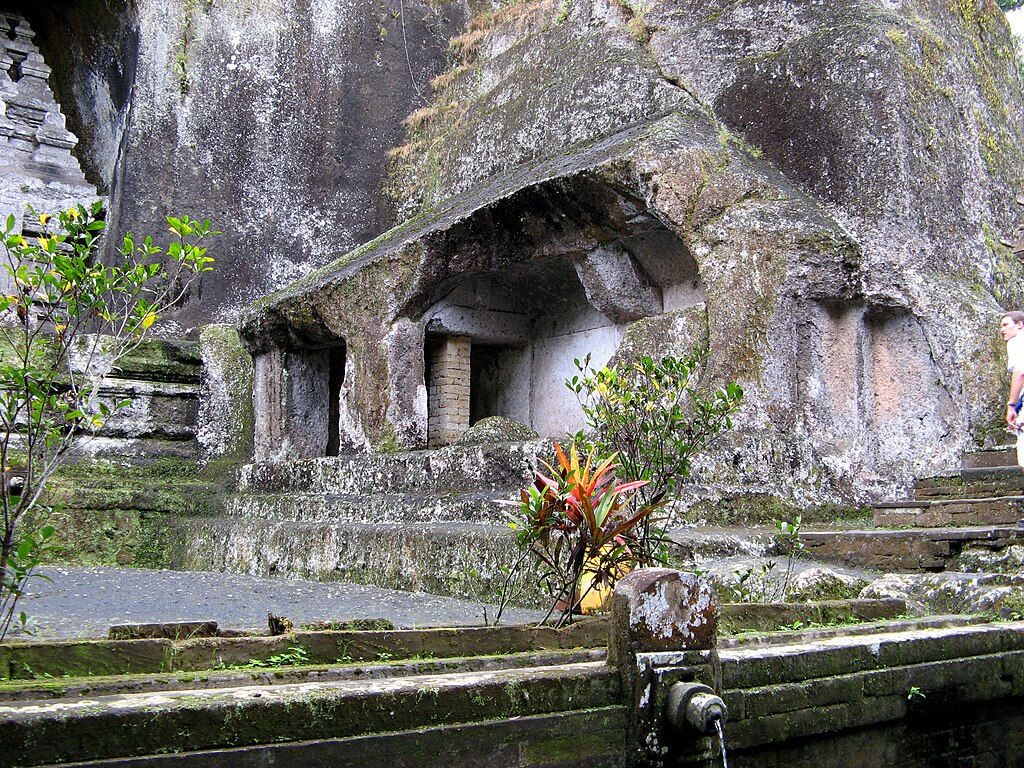
Cloister, Gunung Kawi, Bali. This chamber is located at the right-hand corner of the Kings’ Tombs. Given its location, it probably housed the chief priest who maintained the site and carried out devotions to the departed rulers. Many similar chambers were excavated into the rock in and around the site. These living quarters are usually called “cloisters” or “hermitages” in guidebooks, although neither term is accurate; the residents here were priests, not monks or hermits. Michael Gunther, CC BY-SA 4.0, via Wikimedia Commons
Useful information:
Address: Banjar Penaka, Tampaksiring, Kabupaten Gianyar, Bali 80552, Indonesia
Admission: IDR 15,000 / person
Access: The road is in good condition, so you can easily reach the temple by car or scooter.
Tirta Empul Temple – Central Bali, between Ubud and Mount Batur
A holy spring water temple, Tirta Empul is a place of purification and spiritual cleansing. Visitors can participate in the ritual of bathing in the holy water.
This temple is known for its holy springs, where visitors can bathe in the sacred water. It is believed that the water has healing powers.
Tirta Empul Temple, also called Tirta Empul Spring (Tirta Empul means “sacred spring” in Balinese), is located in the town of Tampaksiring between Ubud and Mount Batur, in central Bali.
The site includes basins known for their holy water where the Balinese go for their purification rituals. One can feel the importance of the place by seeing the many Balinese people coming there to pray and purify themselves.
A beautiful and old Hindu temple which hosts rituals. The temple has holy springs in which devotees bathe. Saranabhi, CC BY-SA 3.0, via Wikimedia Commons
Useful information :
Address: Jl. Tampaksiring, Manukaya, Tampaksiring, Kabupaten Gianyar, Bali 80552, Indonesia
Admission: 50,000 rupees / adult, 25,000 rupees / child (5-11 years old)
Access: The road is in good condition, so you can easily reach the temple by car or scooter.
Goa Gajah (Elephant Cave)
Also known as the Elephant Cave, Goa Gajah is a unique temple that features an entrance shaped like a demon’s mouth. The temple’s interior is adorned with ancient carvings and a statue of the elephant-headed god, Ganesha. The temple’s surroundings are equally beautiful, with lush greenery and a river flowing nearby.
This cave temple is known for its intricate carvings, which date back to the 11th century.

Goa Gajah baths, Bali, Indonesia. Chainwit., CC BY-SA 4.0, via Wikimedia Commons
The temple
Goa Gajah is a Shiava/Buddhist complex that may date from around the 11th century A.D. It consists of the bathing tank seen here, a Rangda cave with statuary and sleeping niches, and the remains of other structures.
It was only excavated and restored in the 1950s, although the cave had been visited by Nieuwenkamp in 1925 (Dutch multi-faceted autodidact. As an artist he was active as a painter, draftsman, sculptor, etcher, lithographer, and designer of book covers and of ex-libris. In addition, he was also known as a writer, architect, explorer, ethnologist and collector of East Asian art.

Goa Gajah (Elephant Cave). LBM1948, CC BY-SA 4.0, via Wikimedia Commons
Inside Elephant Cave
In a small niches, are arranged statues of Hindu gods including those of Brahma, Ganesh and Shiva. The site also has a central basin with, on its edge, 6 statues of women spitting a trickle of water which would have the magical property of preserving youth.

Inside the Goa Gajah. Jakub Hałun, CC BY-SA 4.0, via Wikimedia Commons
Gardens
Continue the visit by following the paths penetrating into the jungle. You will discover a spiritual place, by the river, at the foot of a waterfall where you can swim. Be careful, the passage is narrow and can be very slippery.
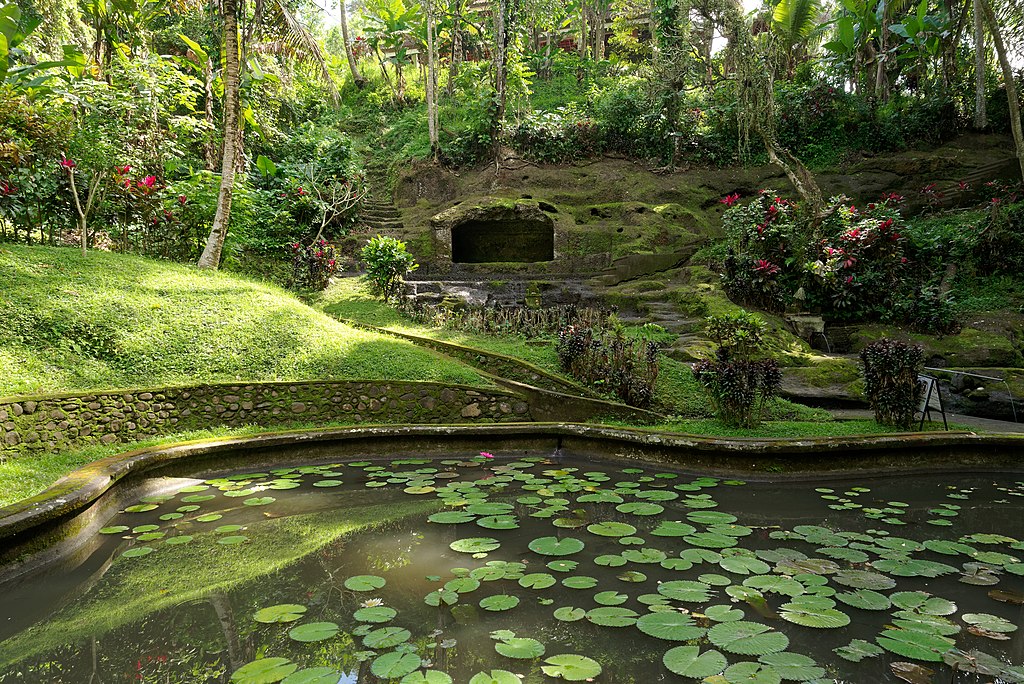
Goa Gajah gardens (Bali island, Indonesia). Jakub Hałun, CC BY-SA 4.0, via Wikimedia Commons
Goa Lawah Temple (Bat Temple)
Carved out of the foothills of Bukit Tengah Mountain and located off the Balinese coast near Kusamba Beach, Goa Lawah Temple is a combination of a temple and a cave housing thousands of mousetowers.
The temple is dedicated to the god of the underworld and is known for its unique architecture.
 Goa Lawah Temple. Arabsalam, CC BY-SA 4.0, via Wikimedia Commons
Goa Lawah Temple. Arabsalam, CC BY-SA 4.0, via Wikimedia Commons

Offering altars at the Pura Goa Lawa or Bat Cave Temple near Kusamba. Tropenmuseum, part of the National Museum of World Cultures, CC BY-SA 3.0, via Wikimedia Commons
Useful information :
Address: Jl. Raya Goa Lawah, Pesinggahan, Dawan, Kabupaten Klungkung, Bali, Indonesia
Admission: 15,000 rupees / person
Access: The road is in good condition, so you can easily reach the temple by car or scooter.
Ubud Monkey Forest Temple
Luhur Uluwatu Temple
The 11th century, Uluwatu temple is located on the southwestern tip of the Bukit peninsula in southern Bali. Built on the cliffs 70 meters (230 ft) high, you can admire a magnificent view of the Indian Ocean and its sunset.
Overlooking the Indian Ocean, it showcases a mesmerizing Kecak Fire Dance performance at sunset.
Take a walk around the temple, in the pleasant gardens, and especially go to the edge of the cliff to enjoy the different views. Beware all the same of the many monkeys very present.

Luhur Uluwatu Temple. LBM1948, CC BY-SA 4.0, via Wikimedia Commons
Kecak Fire dance
You can also attend a Kecak Fire show, this one tells the epic of the hero Ramayana on an open stage with the ocean in the background, the show ends at night with some pyrotechnic scenes.
In Bali, the Kecak dance tells the epic of the Ramayana. About fifty men will bewitch you with their vocal percussion!
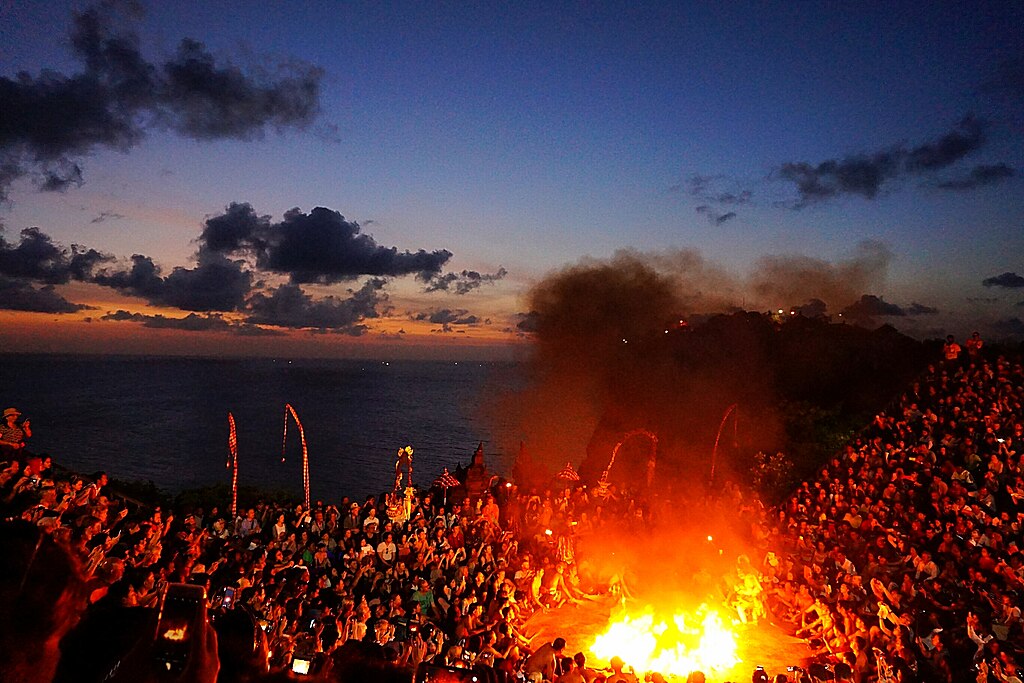
Flaming Fire in one of scenes of Ramayana Kecak Dance performed in Amphiteater Pura Uluwatu, Bali. Johannnindito Adisuryo (Yohanes Nindito Adisuryo), CC BY-SA 4.0, via Wikimedia Commons
From the top of a cliff, the temple of Uluwatu dominates the sea in Bali, in its southern tip. Pilfering monkeys in large numbers in the temple sow discord among visitors (we saw a woman get a shiny flip-flop by a monkey… to recover it, a guard “traded” the sandal for a banana!). I admit that the presence of these monkeys, sometimes quite massive, in freedom, frightened the children (and me too!).
The architectural ensemble of the Uluwatu temple is splendid, and in the evening, an amphitheater welcomes you, with a view of the setting sun, for an impressive performance: a show of the kecak dance.
Inside the temple
Part reserved for the faithful – a sculpture in the arch of a bhoma (son of the forest) protects the sanctuary. In the middle, three doors are majestically decorated with phoenix wings. On full moon nights, the place gives off a strong power, further reinforced by the foaming swell that breaks below with a tremendous crash.
Be careful
There are a lot of monkeys on the sacred place. They will steal everything they can, and only return the object of the larceny in exchange for fruit or other delicacies. They are not aggressive, but nothing should lie around if you don’t want to be surprised by a macaque.
Useful information :
Address: Pecatu, South Kuta, Badung Regency, Bali, Indonesia
Admission: 20,000 rupees / person (+70,000 rupees for the Kecak dance show)
Access: The road is in good condition, so you can easily reach the temple by car or scooter.
http://villacarissabali.com/what-to-do-in-uluwatu-must-visit-places-between-temples-and-beaches-in-south-bali/
http://villacarissabali.com/what-to-do-in-uluwatu-must-visit-places-between-temples-and-beaches-in-south-bali/
Tirta Gangga Water Palace – East Bali
The Tirta Gangga Water Palace, placed on the sacred waters, is a veritable Balinese Garden of Eden where all is beauty. The nature that surrounds the statues, baths and fountains is wonderful.
An enchanting garden with water features and statues, perfect for a leisurely stroll.
For a change from visiting temples in Bali, schedule a visit to Tirta Gangga Palace. It is a very beautiful temple with a water point. Very interesting to walk around and take pictures!
The “Tirta Gangga Water Palace” is indeed splendid, and yet little visited by tourists. And for good reason: to the east of the island, it is far from the most popular spots like Kuta and Ubud. It is located about fifteen kilometers south of Amed (30 minutes by car). Count 2 hours by road if you come from Denpasar.

Tirta Gangga. S A B R I N A B A L I, CC BY-SA 4.0, via Wikimedia Commons
Tirta means “holy water” and Gangga means “Ganges”, the Indian river which is a symbol of a sacred spring in the Hindu religion. The water palace was built in 1946 by the raja of Karangasem and renovated several times.
Very quiet place, and a very beautiful architecture. Allow 1 to 2 hours for the visit.
Tirta Gangga Palace | The Royal Baths and Beautiful Aquatic Gardens in East Bali
Kehen Temple – East Bali
Kehen temple is a Hindu temple complex located in the village of Cempaga, Bangli Regency, Bali, Indonesia. It is dedicated to the Hindu gods Brahma, Vishnu, and Shiva. The temple is believed to have been built in the 13th century, and is one of the oldest and most important temples in Bali.
The temple is like a storybook with three parts, each for a different god. The first part is for Brahma, who created everything. The second is for Vishnu, who takes care of everything. The last part is for Shiva, who brings change.

Kehen Temple. Bangli Regency, East Bali, Indonesia. LBM1948, CC BY-SA 4.0, via Wikimedia Commons
Imagine a big gate with two lion statues standing guard. The temple walls are like a picture book with carvings of gods, goddesses, and magical creatures.
People from all over visit this temple to see its beauty and learn about Bali’s culture. It’s not just for tourists; locals come here to pray too. It’s like a special place that connects people to their beliefs.
Luhur Lempuyang Temple
Located on Mount Lempuyang in East Bali, the temple of Luhur Lempuyang is one of the oldest in Bali. It is part of a group of 7 temples along a hiking path leading to the summit. Pura Lempuyang is located on the slopes of Mount Lempuyang and offers stunning views of the surrounding landscape. Lempuyang temple is also known as the “Gateway to Heaven”.
After climbing the 1700 steps for a good hour, you can admire the magnificent view of Mount Agung and the surrounding nature.

“Heaven Gate” Pura Penataran Agung Lempuyang. Chainwit., CC BY-SA 4.0, via Wikimedia Commons
Useful information:
Address: Bunutan, Abang, Seraya Bar., Kec. Karangasem, Kabupaten Kaangasem, Bali 80852, Indonesia
Admission: 10,000 rupees (minimum donation required)
Access: The road is in good condition, so you can easily reach the temple by car or scooter.
Pura Gunung Lebah
Located along the Campuhan Ridge Walk, it provides a peaceful retreat amidst nature.
A magnificent temple located in the center of Ubud that you can visit quietly… Not to be missed in Ubud.
Sculpture at Purah Gunung Lebah temple in Ubud. Arabsalam, CC BY-SA 3.0, via Wikimedia Commons
This small temple overlooking a river offers a quiet getaway in a very green site.
A path that runs along it allows a pleasant walk in the countryside.
Some sculptures waiting for conservation at Purah Gunung Lebah temple in Ubud. Arabsalam, CC BY-SA 3.0, via Wikimedia Commons
After visiting the temple, you can go to the Campuhan rice fields which are just behind.
Sculptures waiting for conservation at Purah Gunung Lebah temple in Ubud. Arabsalam, CC BY-SA 3.0, via Wikimedia Commons
Samuan Tiga Temple (around Ubud)
A very pretty typical Balinese temple, quiet and very pleasant to see…a pretty place to meditate, take a rest and enjoy the calm of the place.
Samuan Tiga Temple, also known as Pura Samuan Tiga, is an ancient Hindu temple located in the village of Bedulu, Gianyar regency, Bali, Indonesia. This temple is of great historical and spiritual significance, as it is one of the oldest and most sacred temples on the island. The serene and peaceful ambiance of Pura Samuan Tiga makes it an ideal place for meditation and spiritual contemplation.
An ancient temple with three shrines, representing the Hindu trinity.
The name “Samuan Tiga” translates to “Three Meetings” in Balinese, which refers to the temple’s unique feature of having three separate sections, each dedicated to a different god within the Hindu trinity: Brahma, Vishnu, and Shiva. The temple complex is divided into three courtyards, with each courtyard having its own shrines and altars.
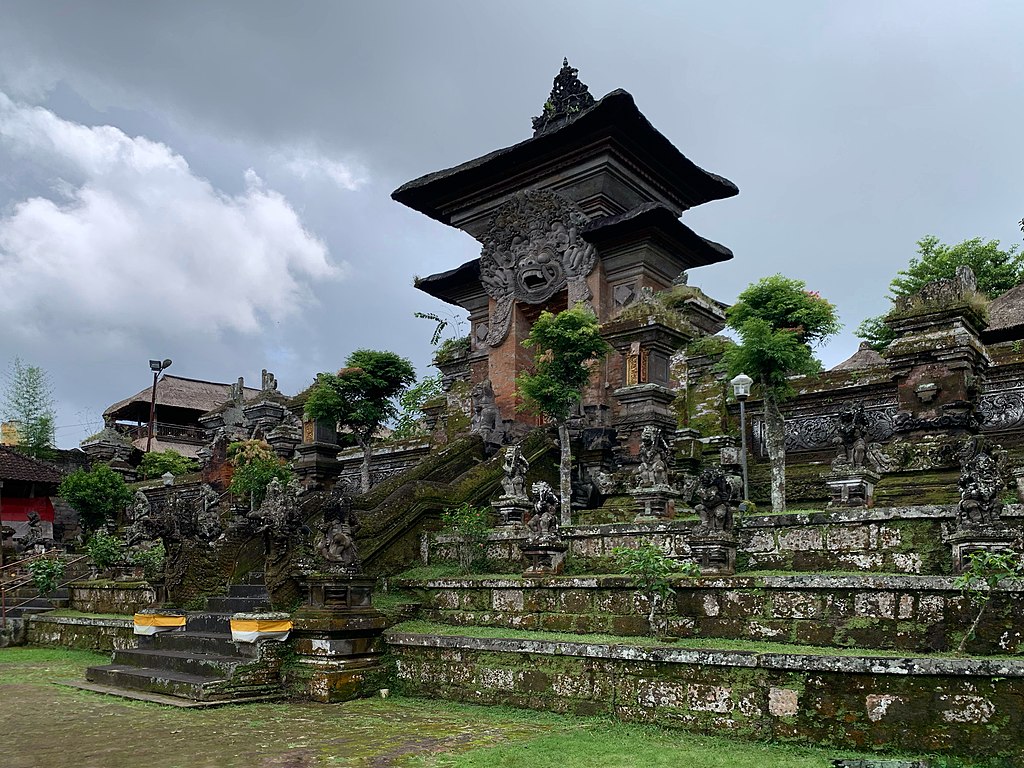
Pura Samuan Tiga. Chainwit., CC BY-SA 4.0, via Wikimedia Commons
The first courtyard is dedicated to Lord Brahma, the creator, and it is where religious rituals and ceremonies are performed. The second courtyard is dedicated to Lord Vishnu, the preserver, and it features a large pavilion where prayers and offerings take place. The third courtyard is dedicated to Lord Shiva, the destroyer, and it contains the main shrine and a sacred bathing pool.

The main entrance of Samuan Tiga Temple. Chainwit., CC BY-SA 4.0, via Wikimedia Commons
For travelers interested in exploring Bali’s rich cultural heritage and religious sites, a visit to Samuan Tiga Temple is a must. It provides a unique opportunity to witness the spiritual practices and rituals that have been passed down through generations and continue to be an integral part of Balinese life.
Pura Saraswati Temple (Ubud Water Palace) – Ubud
This sacred temple pays homage to the Hindu goddess of knowledge and the arts, Sarasvati. Renowned for its enchanting lotus pond and intricate water features, it stands as a serene sanctuary celebrating spirituality and creativity.
Pura Taman Saraswati, officially Pura Taman Kemuda Saraswati, the Ubud Water Palace, is a captivating Hindu temple in Bali. Designed by sculptor I Gusti Nyoman Lempad, it boasts a lotus pond, a unique bridge, and stunning sculptures.
Constructed in 1951, the temple’s inner sanctum is accessed through red-bricked gates and an aling-aling wall. The padmasana shrine, dedicated to Sarasvati, features cosmic turtle carvings.
The temple also includes a pavilion for the Hindu Trimurti, meru towers, and a bale barong for exorcizing rituals. Pura Taman Saraswati stands as a symbol of Balinese art and spirituality in Ubud.
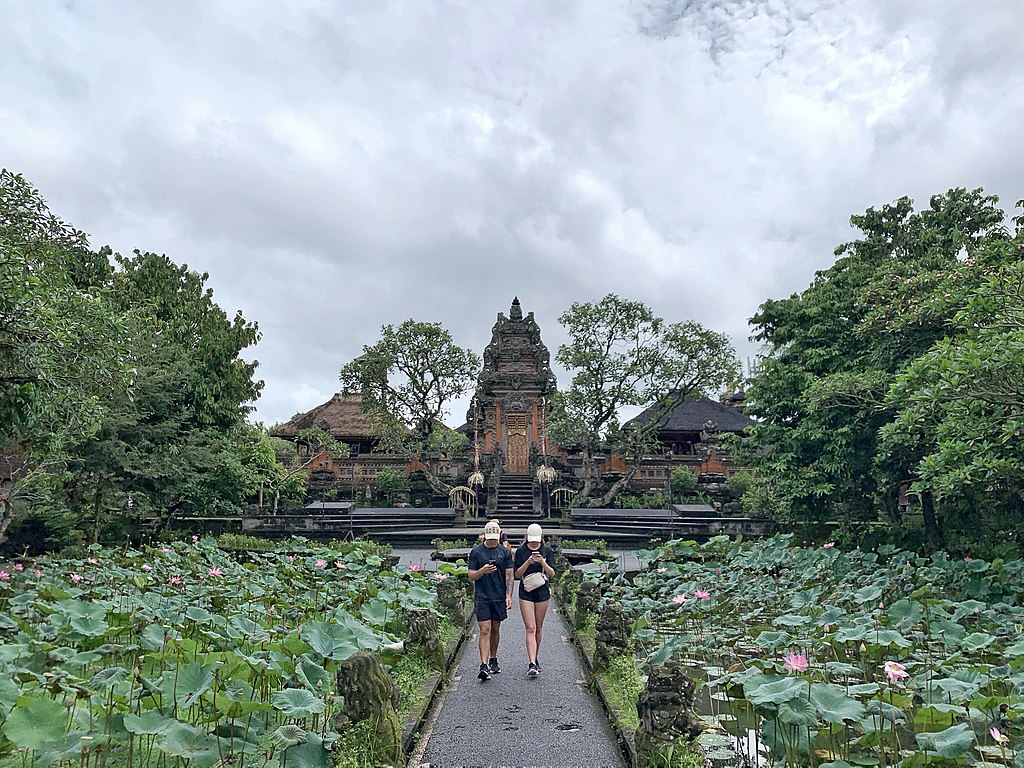
The lotus pond of Pura Taman Saraswati. Chainwit., CC BY-SA 4.0, via Wikimedia Commons
Masceti Temple – Seminyak
Masceti Beach offers a unique mix of elements. Situated about 15km (9.3 miles) east of Sanur, it features a handful of drink vendors and is home to Pura Masceti, one of Bali’s sacred directional temples. The temple, shaped like a garuda (a mythical bird), stands right on the beach and is adorned with vibrant statues. Interestingly, despite the bird-shaped temple, the surrounding area, including a large building, is utilized for cockfights, adding a touch of irony to the scene.
Photo credit (main picture): Keulefm via Pixabay
Things To Do in Bali and What to Visit, Where To Go While Vacationing in Bali? (Top Attractions)
Have you booked your villa in Seminyak center, Bali?
Located in Seminyak Center – Bali, Villa Carissa offers a private swimming pool and enclosed garden to guarantee your privacy. You can book your private pool villa here with us.


